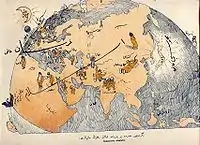Molla Nasraddin (magazine)
Molla Nasraddin (Azerbaijani: Molla Nəsrəddin; Russian: Молла Насреддин) was an eight-page Azerbaijani satirical periodical published in Tiflis (from 1906–17), Tabriz (in 1921) and Baku (from 1922–33; from the 2nd issue of 1931 the magazine was called: Allahsyz (Azerbaijani: «Allahsız»; Azerbaijani: «Аллаhсыз»; Russian: «Безбожник»; translation of the name: "Godless")) in the Azerbaijani and occasionally Russian languages. The magazine was "read across the Muslim world from Morocco to East Asia".[1] It was founded by Jalil Mammadguluzadeh (1866–1932) and Omar Faig Nemanzadeh (1872-1937), and named after Nasreddin, the legendary Sufi wise man-cum-fool of the Middle Ages.[2] Columnists wrote articles that "boldly satirized politics, religion, colonialism, Westernization, and modernization, education (or lack thereof), and the oppression of women".[1]
 Molla Nasraddin #22 (c. 1910) | |
| Editor-in-chief | Jalil Mammadguluzadeh, Omar Faig Nemanzadeh |
|---|---|
| Staff writers |
|
| Categories | Satire |
| Founder | Jalil Mammadguluzadeh, Omar-Faiq Nemanzade |
| Year founded | 1906 |
| Final issue Number | 1933 748 |
| Based in | |
| Language | Azerbaijani |
History
The periodical was founded by Jalil Mammadguluzadeh, a famous Azerbaijani writer, and Omar Faig Nemanzadeh, a prominent educator publicist and writer, published by Geyrat Publishing House owned by both. The name "Molla Nasraddin" was inspired by the 13th century Muslim cleric Nasreddin who was remembered for his funny stories and anecdotes. The main purpose of the magazine was to satirically depict various social phaenomena, such as inequality, cultural assimilation, and corruption; and to ridicule backward lifestyles and values of the clergy and religious fanatics.[3]
Bold and denunciative articles were the reason for numerous searches performed by the police and frequent bans of Molla Nasraddin (in 1912, 1914 and 1917).[4] After a three-year break, Mammadguluzadeh moved to Tabriz, Iran, where within the next year he published eight more issues of the magazine.[5]
The significance of Molla Nasraddin is in its development of the critical realist genre in Azerbaijani literature. It influenced similar processes in other literary traditions, primarily in Iran. Iranian cartoon art emerged as a result of publishing Molla Nasraddin in Tabriz in 1921.[6]
Editorial
Molla Nasreddin’s primary purpose was to attack the hypocrisy of the Muslim clergy using an acerbic sense of humor and realist illustrations reminiscent of a Caucasian Honoré Daumier or Toulouse-Lautrec. It also decried the colonial policies of the US and European nations towards the rest of the world, the venal corruption of the local elite, and equal rights for women while arguing repeatedly for Westernization and educational reform. But publishing such stridently anti-clerical material in a Muslim country in the early 20th century was done at no small risk to the editorial team. Members were often harassed, their offices attacked, and on more than one occasion, Mammadguluzadeh had to escape from protesters incensed by the contents of the magazine.[2]
An issue of Molla Nasraddin would often contain the following articles and columns:[7]
- Discussions
- Facetiae (short witty pieces of writing)
- Feuilletons (journalistic and literary commentary)
- Humorous poems
- Humorous telegrams
- Satirical stories
- Anecdotes
- Postbox
- Humorous advertisements
- Personal advertisements
- Cartoons, caricatures, and illustrations

Popularity
Managing to speak to the intelligentsia as well as the masses, the magazine was an instant success and was read across the Muslim world from Morocco to India. Roughly half of each eight-page issue featured illustrations making the magazine accessible to large numbers people who were illiterate. Its written articles were polyphonic, self-contradictory, and staunchly in favor of the creolization that resulted from multiple languages (it drew on three alphabets). Ideas, and identities (its editorial offices were itinerant between Tbilisi, Baku, and Tabriz).
Demise
During Molla Nasreddin's two and a half decade run, the country at the heart of its polemics and caricatures – Azerbaijan – changed hands and names three or four times. By 1920, the Soviets had invaded Baku affecting the quality of the magazine's editorial and art direction because it was forced to toe the Bolshevik party line.[2] From 1922 to 1933, the magazine was a periodical of the Central and Baku Soviet of the League of Militant Atheists. Starting from the 2nd issue of 1931, the magazine was renamed and until 1933 was published under the title «Allahsyz» (Azerbaijani: «Allahsız»; Azerbaijani: «Аллаhсыз»; Russian: «Безбожник»; translation of the name: "Godless")).[8][9]
Only three issues came out in 1933 and shortly afterwards the magazine closed down. Nevertheless, its legacy cannot be underestimated. Molla Nasreddin offered inspiration to similar pamphleteers from the Balkans to the Middle East and Serbia. The Azeri newspaper Irshad coined the term "Molla Nasreddinism" to describe the ability to tell things as they are.[2]
External links
- "Molla Nasreddin: The Magazine That Would've, Could've, Should've". 15 September 2010. By Slavs and Tatars
- Elements of Humor: Molla Nasreddin in Azerbaijan (1988)
- Khalilova, Konul (28 February 2015). "How Muslim Azerbaijan had satire years before Charlie Hebdo". BBC News. BBC World Service
Language Unity of Azerbaijan, Molla Nasreddin in Tabriz (1920-1921)
References
| Wikimedia Commons has media related to Molla Nasreddin. |
- "The Magazine That Almost Changed The World". The New Yorker. Retrieved 26 May 2011.
- "New-York Books: When Satire Conquered Iran", nybooks.com, 18 September 2012.
- Molla Nasraddin - The Magazine: Laughter that Pricked the Conscience of a Nation by Jala Garibova. Azerbaijan International. #4.3. Autumn 1996.
- Molla Nasraddin, an entry from the Great Soviet Encyclopaedia, Baku.ru; accessed 5 January 2018.
- Famous Personalities of Nakhichevan: Jalil Mammadguluzadeh, Shexsiyyeter.nakhchivan.az; accessed 5 January 2018.
- (in Persian) Molla Nasraddin and Jalil Mammadguluzadeh by Ebrahim Nabavi. BBC.co.uk, 6 July 2006.
- Guliyev, Hasan. Mammadguluzadeh, Jalil Archived 1 March 2007 at the Wayback Machine, Литературный Азербайджан; accessed 5 January 2018.
- "Periodicheskaia pechat' SSSR". May 23, 1955. Retrieved May 23, 2020 – via Google Books.
- Peris, Daniel (May 23, 1998). Storming the Heavens: The Soviet League of the Militant Godless. Cornell University Press. ISBN 0801434858. Retrieved May 23, 2020 – via Google Books.
